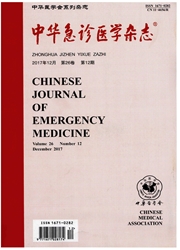

 中文摘要:
中文摘要:
目的 通过建立心搏骤停室颤-心肺复苏模型,观察心肺复苏后猪心肌、大脑、肺脏、肝脏及肾脏组织普通病理和超微结构的变化及对血流动力学的影响.方法 16头北京长白猪(29~35kg)随机(随机数字法)分为正常组(n=8)与复苏组(n=8).前组动物仅进行麻醉及气管插管,不予致室颤及心肺复苏.后组动物在建立心搏骤停室颤模型4 min后给予标准心肺复苏术,恢复自主循环(ROSC)10 min后以0.5 mL/(h·kg)的速度持续静脉泵入生理盐水直至复苏后6 h,并分别于致颤前,ROSC后0.5 h,2 h,4 h,6 h监测心排血量(CO)、左心室收缩期压力最大上升速率(+dp/dtmax)、左心室舒张期最大下降速率(-dp/dtmax)、心率(HR)、平均动脉压(MAP),两组动物均于复苏6 h后静脉麻醉下处死,速取其左心室心尖、大脑顶叶皮层、左肺、肝右叶、右肾上极组织行普通病理学及透射电镜检查.对实验数据用t检验的方法进行统计学分析.结果 复苏组在ROSC后各时间点,左心室收缩期压力最大上升速率、左心室舒张期最大下降速率、心排血量与致颤前相比均明显降低,差异具有统计学意义(P<0.05),复苏组ROSC后各时间点HR较致颤前明显增加(P<0.05),各时间点MAP之间比较差异无统计学意义(P>0.05);通过对苏木精-伊红(HE)染色切片及透射电镜切片的观察,进行正常组与复苏组动物各主要脏器组织病理学比较,心搏骤停室颤-心肺复苏模型中猪的心肌、大脑、肺脏、肝脏及肾脏组织均存在不同程度的病理损伤,以心肌、大脑、肺脏的损伤更为严重.结论 心搏骤停-心肺复苏对机体各主要脏器均可以造成不同程度的形态学损伤及血流动力学影响,在ROSC成功6 h的模型中,以心肌、大脑及肺的损伤较重,肝、肾的损伤较轻.
 英文摘要:
英文摘要:
Objective To investigate the microstructure and ultrastructure changes of cardiac muscle, pallium, lung, liver and kidney tissue and hemodynamic effects after the success of cardiac arrest (CA)-cardiopulmonary resuscitation(CPR) of swine. Method A total of 16 Beijing swine(weight 29 ~ 35 kg)were randomly (random number) divided into normal-control group ( n = 8) and standard CPR group ( n = 8). The swine of the former group were only given anesthetized and intubated, without ventricular fibrillation and CPR. The swine of the latter group were given standard CPR after 4 min of untreated VF, from 10 min after restoration of spontaneous cirkg) and keep for 6 h. And cardiac output (CO), left ventricular maximal rate of systolic pressure ( + dp/dtmax),maximum reduction of left ventricular diastolic velocity ( - dp/dtmax), heart rate (HR) and mean arterial pressure (MAP) of these animals before ventricular fibrillation and 0.5 h, 2 h, 4 h, 6 h after ROSC have been monitored.All swine were put to death after 6 h,and got their cardiac apex, pallium, left lung, right lobe of liver and upper pole of left kidney quickly for microstructure and ultrastructure studies. Statistical analysis was performed using two paired samples t test. Results At different time points after restoration of spontaneous circulation, the cardiac output (CO),left ventricular maximal rate of systolic pressure ( + dp/dtmax), maximum reduction of left ventricular diastolic velocity (- dp/dtmax) were significantly lower than before ventricular fibrillation, with significant difference ( P 〈 0.05). And HR of different time points were increased significantly ( P 〈 0.05), with no significantly difference between MAP of each time points ( P 〉 0.05). Compared with the normal-control group, the cardiac muscle, pallium, lung, liver and kidney tissue of the swine in standard CPR group were found different degree of damages in their microstructure and ultrastructure sections. The
 同期刊论文项目
同期刊论文项目
 同项目期刊论文
同项目期刊论文
 Effect of continuous compressions and 30:2 cardiopulmonary resuscitation on global ventilation/perfu
Effect of continuous compressions and 30:2 cardiopulmonary resuscitation on global ventilation/perfu Mild Hypothermia Attenuates Mitochondrial Oxidative Stress by Protecting Respiratory Enzymes and Upr
Mild Hypothermia Attenuates Mitochondrial Oxidative Stress by Protecting Respiratory Enzymes and Upr Cerebrospinal fluid biochemistry reflects effects of therapeutic hypothermia after cardiac arrest in
Cerebrospinal fluid biochemistry reflects effects of therapeutic hypothermia after cardiac arrest in Load-distributing band improves ventilation and hemodynamics during resuscitation in a porcine model
Load-distributing band improves ventilation and hemodynamics during resuscitation in a porcine model Molecular mechanisms of therapeutic hypothermia on neurological function in a swine model of cardiop
Molecular mechanisms of therapeutic hypothermia on neurological function in a swine model of cardiop 期刊信息
期刊信息
